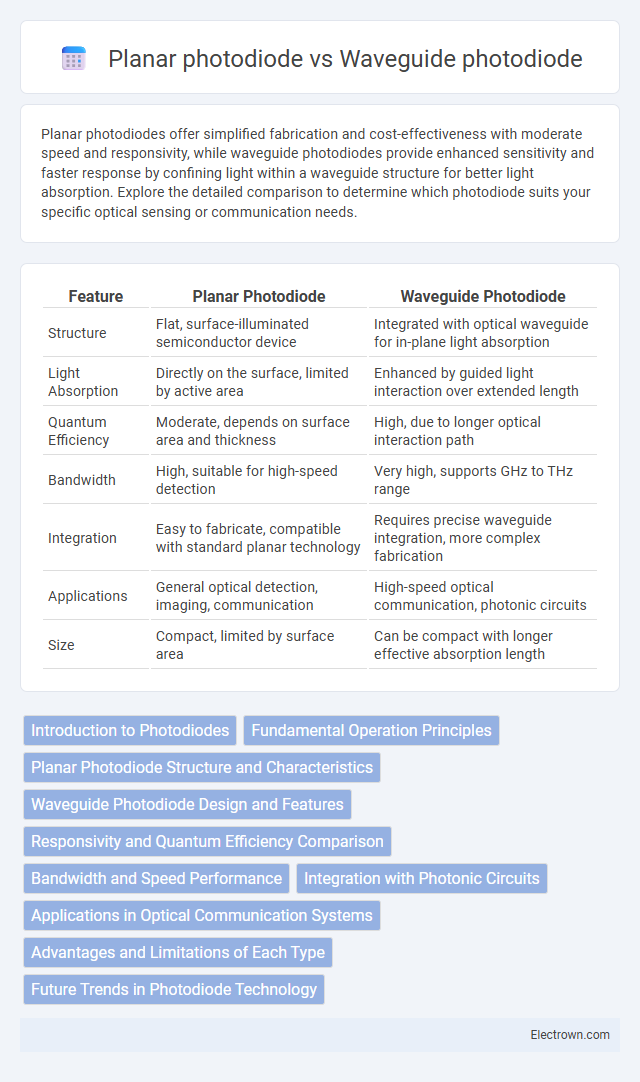Planar photodiodes offer simplified fabrication and cost-effectiveness with moderate speed and responsivity, while waveguide photodiodes provide enhanced sensitivity and faster response by confining light within a waveguide structure for better light absorption. Explore the detailed comparison to determine which photodiode suits your specific optical sensing or communication needs.
Table of Comparison
| Feature | Planar Photodiode | Waveguide Photodiode |
|---|---|---|
| Structure | Flat, surface-illuminated semiconductor device | Integrated with optical waveguide for in-plane light absorption |
| Light Absorption | Directly on the surface, limited by active area | Enhanced by guided light interaction over extended length |
| Quantum Efficiency | Moderate, depends on surface area and thickness | High, due to longer optical interaction path |
| Bandwidth | High, suitable for high-speed detection | Very high, supports GHz to THz range |
| Integration | Easy to fabricate, compatible with standard planar technology | Requires precise waveguide integration, more complex fabrication |
| Applications | General optical detection, imaging, communication | High-speed optical communication, photonic circuits |
| Size | Compact, limited by surface area | Can be compact with longer effective absorption length |
Introduction to Photodiodes
Photodiodes convert light into electrical current, with planar photodiodes featuring a flat, layered structure that offers high-speed response and ease of integration in optical circuits. Waveguide photodiodes incorporate light-guiding structures enabling efficient coupling between optical waveguides and the photodetector, which enhances sensitivity and bandwidth for photonic integrated circuits. Both types serve critical roles in optical communication systems, but waveguide photodiodes excel in compact, high-performance applications due to optimized light-matter interaction.
Fundamental Operation Principles
Planar photodiodes operate based on vertical absorption of incident photons within a layered semiconductor structure, where the generated electron-hole pairs are collected across a p-n junction typically perpendicular to the device surface. Waveguide photodiodes integrate a waveguide to route light laterally through an absorption region, enhancing the interaction length and thus improving quantum efficiency and bandwidth by facilitating efficient photon-electron conversion along the propagation path. The fundamental distinction lies in the planar device's vertical charge carrier collection versus the waveguide photodiode's lateral optical confinement and detection mechanism.
Planar Photodiode Structure and Characteristics
Planar photodiodes feature a lateral PN junction built on the semiconductor surface, enabling efficient carrier collection with minimal capacitance, which enhances speed and sensitivity. Their structure supports compact integration with other photonic components, offering low dark current and high quantum efficiency due to optimized surface passivation. This planar configuration is favored in high-speed optical communication systems where low noise and fast response are critical.
Waveguide Photodiode Design and Features
Waveguide photodiodes feature a design that integrates the photodiode directly with an optical waveguide, enhancing light absorption efficiency and bandwidth performance compared to planar photodiodes. The waveguide structure enables longer interaction lengths between the optical signal and the active region, resulting in higher responsivity and faster response times. These photodiodes are crucial for high-speed optical communication systems due to their compact footprint and improved signal-to-noise ratio.
Responsivity and Quantum Efficiency Comparison
Planar photodiodes typically exhibit moderate responsivity and quantum efficiency due to their simpler structure, which limits light absorption efficiency. Waveguide photodiodes enhance responsivity by guiding light along a longer interaction path within the active region, resulting in higher quantum efficiency and improved signal detection. Your choice between these photodiodes depends on the required sensitivity and application-specific performance metrics.
Bandwidth and Speed Performance
Planar photodiodes typically exhibit moderate bandwidths around a few GHz, limited by their junction capacitance and carrier transit time, making them suitable for standard optical communication applications. Waveguide photodiodes achieve significantly higher bandwidths exceeding 40 GHz due to reduced carrier transit distances and enhanced optical confinement within the waveguide structure. This architectural advantage in waveguide photodiodes results in superior speed performance ideal for high-speed data transmission and advanced photonic integrated circuits.
Integration with Photonic Circuits
Planar photodiodes offer straightforward integration with photonic circuits due to their simple fabrication process on flat substrates, enabling compact and cost-effective designs. Waveguide photodiodes enhance integration by directly coupling light from on-chip waveguides, providing higher responsivity and bandwidth essential for dense photonic integrated circuits. Your choice between the two depends on the required performance metrics and the complexity of the photonic circuit design.
Applications in Optical Communication Systems
Planar photodiodes are widely used in optical communication systems for high-speed data detection due to their fast response time and ease of integration with electronic circuits. Waveguide photodiodes offer enhanced efficiency and sensitivity by coupling light directly into the photodiode through an integrated waveguide, making them ideal for dense wavelength division multiplexing (DWDM) and on-chip optical interconnects. Your choice between planar and waveguide photodiodes depends on the specific system requirements for bandwidth, integration density, and sensitivity.
Advantages and Limitations of Each Type
Planar photodiodes offer advantages such as ease of fabrication, low dark current, and good sensitivity for surface-illuminated applications, but they are limited by slower response times and larger capacitance compared to waveguide photodiodes. Waveguide photodiodes provide higher bandwidth, enhanced coupling efficiency, and compact integration with optical waveguides, making them ideal for high-speed photonic circuits; however, they require more complex fabrication processes and precise alignment. The choice depends on application requirements, balancing speed, sensitivity, and integration complexity.
Future Trends in Photodiode Technology
Planar photodiodes are evolving with enhanced integration capabilities for compact optoelectronic circuits, while waveguide photodiodes continue advancing in speed and efficiency for high-bandwidth applications. Innovations in material science and nanofabrication are driving both technologies toward higher sensitivity and lower noise levels, critical for future 5G and beyond communication systems. Your choice will depend on whether miniaturization or performance in ultra-fast data transmission is the priority in next-generation photonic devices.
Planar photodiode vs Waveguide photodiode Infographic

 electrown.com
electrown.com